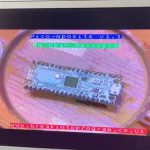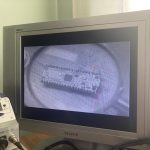Pico-mposite Colour
My first project on the Pico was the Pico-mposite, a breadboard circuit and application that demonstrated how to generate a black and white composite video signal in software using the Pico’s PIO cores and DMA and a resistor ladder as a digital to analogue convertor. The project went through a couple of iterations; from a hacked together demo to something that was a bit more usable and, more importantly, was ready, at least in principle …



